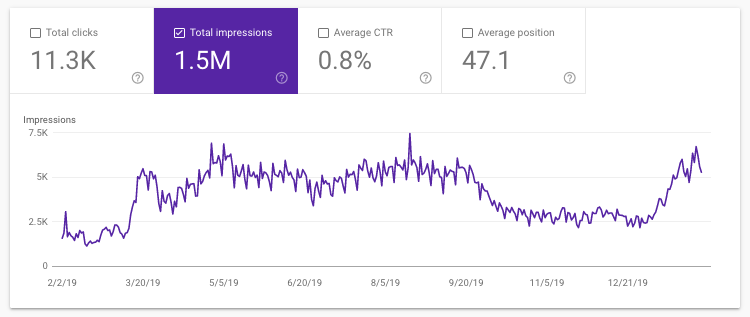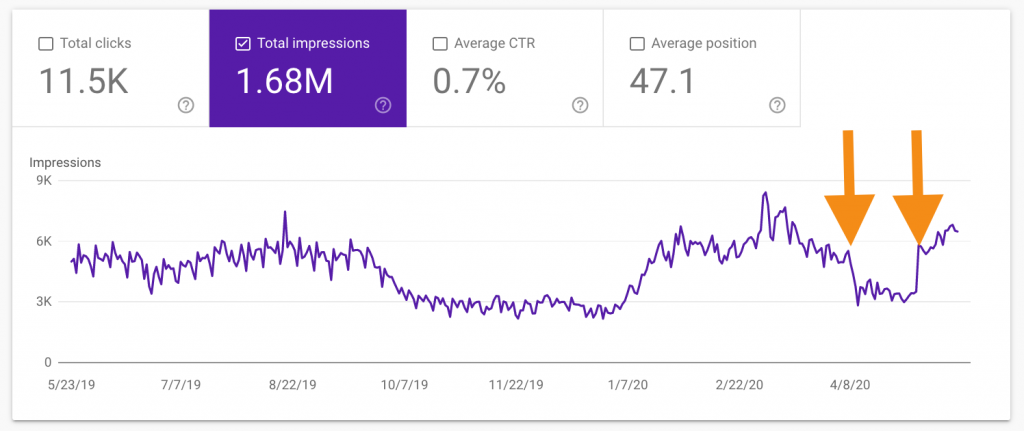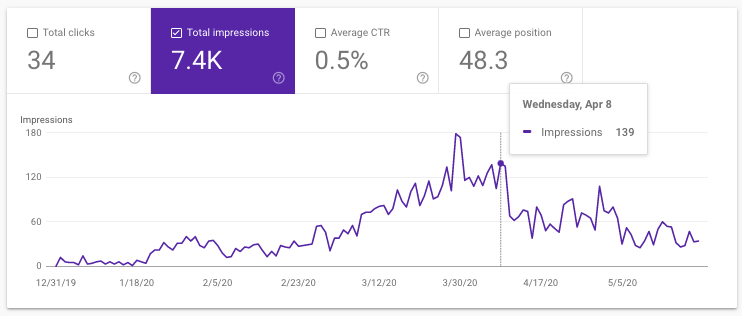In January this year I wrote a post all about riding the Google core algorithm update rollercoaster, and the patterns and trends I observed when this website was impacted both negatively and positively by two separate confirmed updates (September 2019 and January 2020).
Without needing to go back through that article, this is what the graph looked like come February 3rd 2020:

And the TLDR of that post:
- Competitors upped their content game, especially around niche platforms (including the niche platform) to rank for its own brand + SEO, so based on those pages bringing in zero leads and not wanting to compete for zero more leads, I deleted those pages.
- I went on a big clean-up of blog content that was bad. Not based on length and such, but just stuff that had very few visits and reading back two years later made me sigh.
- I also removed pages targeting phrases such as “SEO travel”, as the leads coming in from those pages were too small to be serviced in a viable fashion, and strangely the big travel clients I’ve worked with have all come through other topic areas.
As you’ve probably guessed from the title of this article, we’ve bought another ticket for the fayre ground and have once again taken a ride on the rollercoaster, but this time it’s different, and this time the “fun” started whilst we were still waiting in line.
Between the uptick in January 2020 to now, I’ve pretty much neglected my own website in terms of posting content regularly as I’ve been blogging elsewhere and started to do the YouTube thing.
So what does the second rollercoaster look like? This:

The two dates the arrows point to are April 7th 2020 and May 4th 2020.
Now we know that there was an update on May 4th, and SERoundTable did report some flutters on the week before, but there’s not much reported for April 7th (which does tie in with Barry S taking some deserved time off and posts going out that week being scheduled).
Analyzing The Ride
Ahead of most Google changes, there can sometimes be “warning signs”. I know that Google rolls out updates pretty much all the time to various SERPs, individual queries, and even whole parts of the algorithm. Based on the data available in multiple GSCs available to me, and third-party volatility tools, I believe there was a change made in and around April 7th – and across multiple queries.
For example, this is a local entertainment agency (already taking a hit from Corona) but again seeing a sudden drop around April 7th and then some small recovery at the start of May:

And then a blog website which saw a drop on April 8th, and then a further drop on May 4th:

There are other examples correlating the April 7th and May 4th trends, but, I can’t really share their GSC screenshots.
Another time period that became suspicious quickly was that of April 11 to April 28th… As the below graph shows:

This isn’t a traffic-driving keyword so wouldn’t have shown in the normal reporting, and as far as I can tell (from using tools like ContentKing), and other data from GA – the page that corresponds with this keyword had no issues during this period and had no changes made to the content or meta.
Analyzing The Data
So looking through my data, what are the immediate observations…
I lost impressions for and then regained impressions for the below terms between April 7th and May 4th
- SEO consultancy
- SEO site audit
- Site audit
- YouTube SEO (which I have one blog post about, so not surprised)
- How to rank videos on YouTube
On April 7th I saw improvements for the below keywords, which has been sustained since:
- eCommerce SEO consultant
This is where it’s important to note that GSC data does differ from Google Analytics, as in real terms I didn’t lose half my organic traffic over the period:

What Did The Core Algo Affect
So, getting the obvious question out of the way – what did I do post-April 7th to ascertain why my impressions had almost halved overnight? The answer, nothing.
During the period of April 7th to March 4th, looking at the sites now ranking for my important, traffic-driving terms I could kind of understand why I had lost performance, and the answer wasn’t to make a kneejerk response as the sites (and content) now ranking had invested more content and PR over a period of time, and I hadn’t.
Like most things core algorithm updates “change”, the data is built up over a long period of time, such as long click v short click data, and given how queries and users can change behavior and expectations it is almost impossible to identify vulnerability to or prepare for over a long period of time – aside from glaringly obvious issues such as:
- Bad technical
- Content not matching user expectations or the query
- Increased competition activities
Based on the observations from the three sites above, and multiple other websites and data set my conclusion is that this core update has been much like any other:
- RankBrain has likely gotten better through processing an unimaginable volume more of data
- More time has passed for evaluators to feedback into the algorithm to refine the accuracy
- A virus struck the world, so people’s lifestyles changed and therefore their internet behaviors
- Data aggregated over a long period of time, such as short click v long click, will have been factor along with the change in user behavior
- All websites will have been making some form of effort (high or low) to move the needle, and oftentimes a core update such as this rebalances the SERPs and if you have been making high efforts you can see a reward
And, as always, sometimes somethings make no sense – and, as always, the issue might not be related to your “SEO” in a silo, but also your marketing/PR/branding/social and the sentiment in which people talk about you online (down to your products, customer service, issue handling, etc).